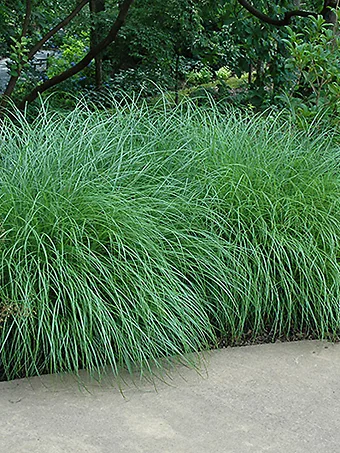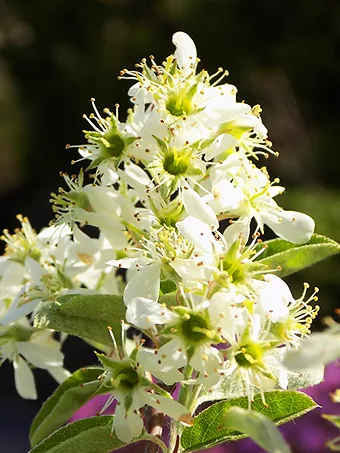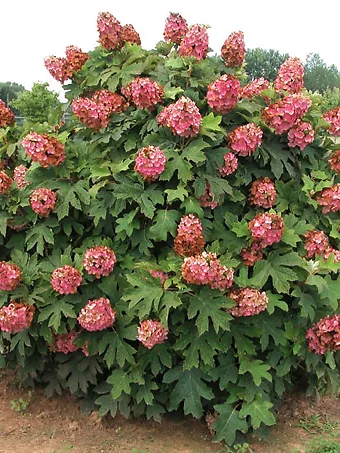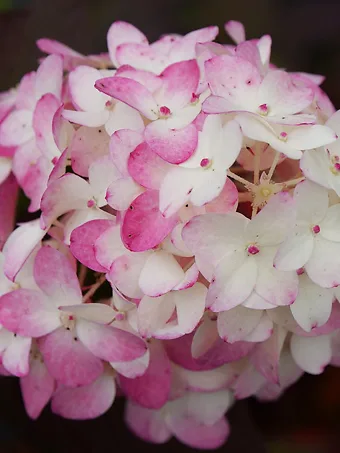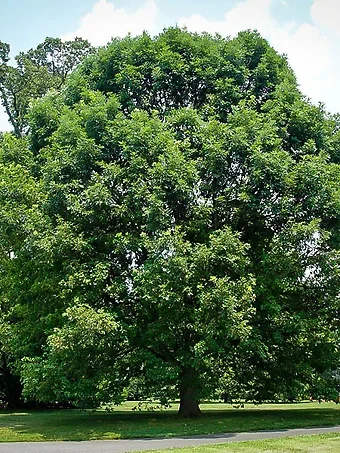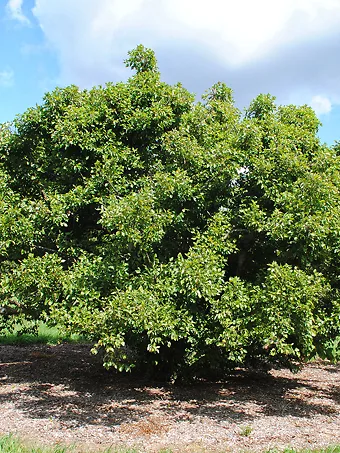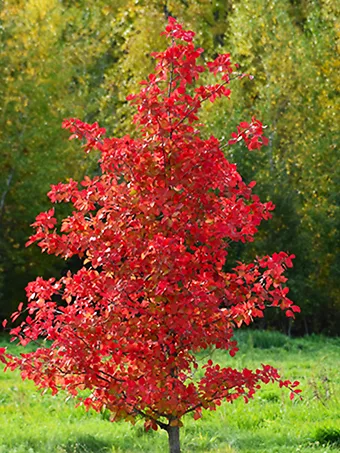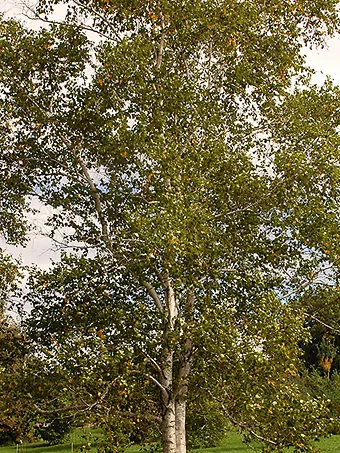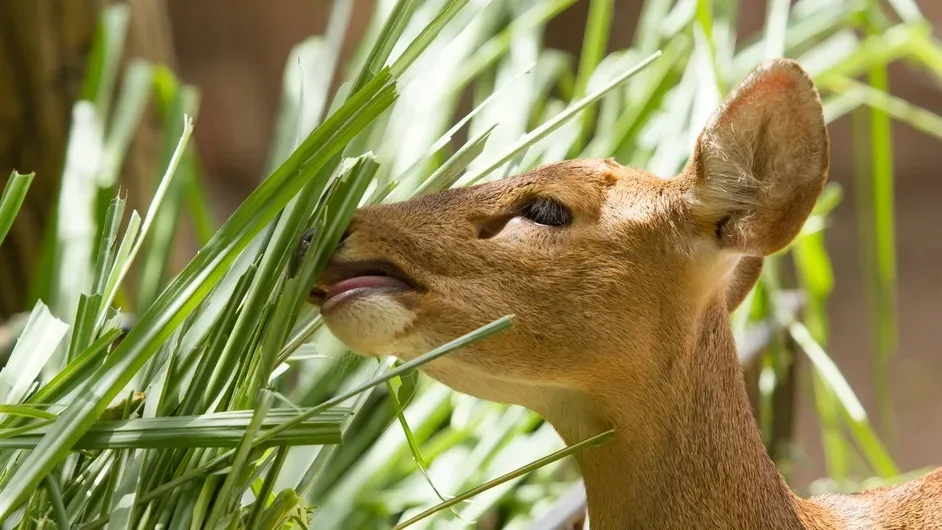
Written by s • Best Deer Resistant Plants and Shrubs For Your Area
Deer pose a pesky nuisance for gardeners. Though they may be enjoyable to look at, deer will nibble on many types of popular landscaping trees. The damage deer cause can lead to trees that appear sickly or malnourished. The tree can suffer from more than just appearance issues – significant deer damage can impact the future life of your plant, and even cause it to die much earlier than it should.
Deer damage trees in several ways. During winter, food resources for deer dwindle. To get through these tough months, deer rely on the lichens that grow on trees to suffice for food. In eating the lichens off the trees, deer will rip off strips of bark, exposing the tree to the harshest seasonal elements. Deer also feed on evergreen leaves, or needles, often completely removing entire layers of the shrub or tree. The damage deer can do to trees can oftentimes devastate the tree permanently.
Antler rubbing is another common behavior that can negatively impact the growth of trees. Male deer will rub their antlers against trees in order to remove the velvety film. This damage, which occurs primarily on flexible and smaller tree limbs, can remove the entre outer bark and even damage the tree’s vascular tissue.
After all this worrisome news, it can be comforting to learn that there are ways to circumvent these pesky pests. Netting and fencing can provide temporary relief, but these can also become expensive, cumbersome, and unattractive. Planting plants that deer find unattractive can be one tool for dealing with high deer populations.
For homeowners who plant in areas laden with deer, these types of plants can be an essential tool to deter these majestic, but destructive, animals. Engaging in some proper research can make the difference between aggressive deer damage and a successful, deer-resistant garden attraction.
Deer tolerant plants come in a variety of types, and they cover all manner of plant types: shrubs, trees, shade plants, and evergreens. These commonly affected plants have cultivars that are capable withstanding the most abhorrent of deer attacks. These medium-sized mammals can be enjoyable to watch (and even get up to close to in deer parks), but they can be a deadly pest in the garden. Check out some of these deer-resistant plants, collected by The Tree Center experts, and plan out your pest-resistant garden today.
Deer Resistant Shrubs
Shrubs, which are usually smaller than trees, usually have more than once central stem that extends outward from the base of the plant. Shrubs are frequently eaten by deer due to their low height and accessible edible bits.
Gardeners love to plant shrubs. These smaller plants can add a variety of landscape qualities that would otherwise be absent from the garden – levels, texture, and color. Without shrubs, what could have been called a garden becomes an orchard or flower-bed. Shrubs add variety. Many shrubs are planted to create privacy walls and accent features in the yard. How often have you seen the common American boxwood shrub planted by a neighbor’s front door or a colorful rhododendron shrub at the house’s corners? Character attends the yard where shrubs are planted to strategically add cover, class, and color.
Unfortunately, deer can significantly damage the shrubs homeowners plant. Shrubs, which are typically closer to the ground, are at a higher risk for severe damage than trees, whose height makes them a smaller target. Shrubs are commonly devastated by the curious creatures who wander our woods.
Luckily, there are dozens of deer-resistant shrubs available. These shrubs have a variety of characteristics that make them unpopular to deer. We have collected a few of the most popular deer resistant shrubs here, and we have also compiled a much longer list below.
Prepare a garden selection free from the devastating effects of deer. Though a nibble here and there may occur, your overall garden appearance and health will blossom with the proper plant preparation and planting. And flowers, too!
Arrow Wood Viburnum
This flowering shrub displays creamy white flowers in the spring and vibrant blue to black berries in the early fall. Though birds will frequent the bush in the autumn for their meals, deer appear to have little interest in the Arrow wood Viburnum, which is found in most regions of the United States, except the farthest south and southwest regions. Expect your shrub to reach between 6 and 15 feet in height.
Barberry
A common garden plant, the Barberry (sometimes spelled Berberry) shrub is a medium-sized high-interest, low-maintenance plant. Frequently planted as a hedge or foundation plant, the Barberry displays luscious ruby to burgundy colors in its leaves, though some species include more yellow tones. Frequently thorny, the Barberry deters deer and grows easily in many types of environments.
Daphne
Daphne plants can be either deciduous or semi-evergreen, and they compose a variety of broad-leafed flowering shrubs. Daphne plants are typically fragrant and display clusters of tubular flowers that vary in color from light pinks and whites to blues and purples. The Daphne is a beautiful ornamental bush (one of my favorites). Even better? Deer won’t bite the flowers as they are want to do on other flowering shrubs.
Fragrant Sumac
With a wildflower attitude, the Fragrant Sumac provides a plant with manageable growing rates, pest and insect invulnerabilities, and, as the name implies, a pleasant odor when the twigs or leaves are bruised. This small, 2 to 4 foot shrub, repels deer and instead offers tiny yellow spring flowers and supple autumn colors and fruit.
Heather Shrub
Most Heathers bloom in summer, providing stunning clusters of purples and pinks. Landscapers love Heather, which grows easily on poor soil, hillsides, and ledges. For this reason, Heather is frequently used as a border plant, lining garden walls, and in the undergrowth as a colorful foundation plant. In addition to these traits, Heather is also resistant to the devastating effects of deer.
Other Deer Resistant Shrubs
Arrow Wood Viburnum
Blue Mist Shrub
Bush Cinquefoil
Daphne
Devil’s Walking Stick
Drooping Leucothoe
Fragrant Sumac
Heath
Heather
Andromeda Japanese Pieris
Japanese Plum Yew
Japanese Skimmia
John T. Morris Holly
Leatherleaf Mahonia
Mountain Pieris
Prince of Wales Juniper
Red Elderberry
Russian Cypress
Russian Olive
Sweet Box
Deer Resistant Trees
Trees, though significantly taller than their kinsman shrubs, are also prone to the effects of deer. Most often, trees grow lichens and mosses during the spring and summer months. In autumn and winter, when the other greenery has died or been ingested, deer will begin to pick away at the bark and living material growing on trees.
The bark may seem like it’s only the tough exterior to the plant, and this is, in part, true. The bark of the tree is similar to your skin, or epidermis. It provides protection from the elements and helps keep all the innards, well, in!
Just like a person with damaged or serious skin conditions (such as eczema, psoriasis, or cancer), trees, too, can suffer from diseases or infestations to their skin. Deer provide one of the most serious of these infestations, as their respective size can greatly affect the well-being of a tree.
There are several types of tree that can withstand these negative effects caused by deer. These deer-resistant trees can border properties, sometimes acting as an invisible fence line for the deer population. More often, they are at least able to care for themselves, using their deer protective skin to survive tough winters.
We have collected a few of the most popular deer resistant trees for you that grow in the United States. These trees are used for landscaping and backyard planting, and they will deter infestations of deer. We have also compiled a list of deer resistant trees that you can peruse if you are considering a tree planting in your backyard.
Bottlebrush Buckeye
Reaching up to 12 feet tall, the Bottlebrush Buckeye is a small flowering tree that produces incredibly showy pink to red clusters of flowers up to a foot in height. For this reason, the Bottlebrush Buckeye is commonly planted as an ornamental or accent tree.
Autumn is another beautiful season, as the dark green, glossy leaves give way to yellow foliage. Though the flowers are within easy reach for deer, these mammals do not feed on them, finding the taste quite bitter.
Katsura Tree
A truly impressive tree, the Katsura tree reaches between 40 and 60 feet tall. Commonly planted as a shade tree, the Katsura Tree offers shape and texture with gently rounded leaves and tiny red and green flowers that bloom in spring. The Katsura, which provides low shade (perfect for placing a bench underneath), is not an enticing dish for deer.
Mimosa Tree
Beautiful to behold, the Mimosa tree is a mid-summer bloomer. Fern-like leaves add texture and shape to the garden landscape. In addition to its unique leaves, the Mimosa tree also displays exotic pink flowers that dazzle onlookers. Neighbors will be stopping by to ask what tree offers such beauty and keen privacy. Deer will avoid this tree.
Paper Birch
This year-round beauty is popular in autumn, as its white bark begins to contrast dramatically with vibrant golden leaves. Frequently found along small streams and rocky slopes, the Paper Birch grows well in a variety of soil types and landscapes. The Paper Birch can reach up to 70 feet tall, though young saplings will range between 10 and 20 feet for the first few years. Though deer may visit the Paper Birch tree, they will not nibble.
Pawpaw Tree
The lovely Pawpaw tree is a popular tree that offers tropical ambience and wind protection. Large leaves display themselves on this small, 25 foot tall tree. The Pawpaw is often planted for its fruit, which can be eaten. Fruit gains can be increased by planting the Pawpaw tree in full sun with at least one additional Pawpaw tree for pollination purposes. Deer are turned away from the taste of the Pawpaw tree.
Common Sassafras
Three unique leaves are grown by the Common Sassafras tree, which has been used to make teas and other edible treats. Careful, though; ingesting large amounts of Sassafras can be damaging to human health, which is why deer are also uninterested in this tree. Reaching up to 60 feet tall, the Sassafras tree has a vague lemon scent and provides stunning beauty and sturdy summer shade.
Japanese Maple
This small tree offers color throughout the growing season, displaying rich burgundy-purple to maroon tinted leaves. Twisted branches add shape and texture to the garden landscape. There are many Japanese Maple varieties that display different shapes: weeping, cascading, and elegant canopies. Deer will not bite this winning landscape tree.
Other Deer Resistant Trees
Bottlebrush Buckeye
Japanese Black Pine
Katsura Tree
Paper Birch
Pawpaw Tree
Pitch Pine
Red Pine
Allegheny Serviceberry
Austrian Pine
Chinese Fringe Tree
Chinese Paper Birch
Colorado Blue Spruce
Common Flowering Quince
Common Sassafras
Downy Serviceberry
Dragon Lady/ San Jose Holly
Eastern Red Cedar
English Hawthorn
European Ash
European White Birch
Green Ash
Himalayan Birch
Japanese Cedar
Japanese Falsecypress
Japanese Flowering Cherry
Japanese Maple
Japanese Red Pine
Norway Spruce
Paperbark Maple
Ruby Horsechestnut
Scotch Pine
Serbian Spruce
Shadbush
Sourwood
Striped Maple
White Spruce
Yellow Birch
Deer Resistant Shade Plants
There are two types of shade plants to consider: plants that produce shade and plants that grow well in the shade. We have covered both!
Shade is a valuable commodity. Trees that produce shade, therefore, can be beneficial in a variety of ways. First, shade producing trees provide shade under which people, pets, and plants can rest. Second, the shade they produce can also have a cooling effect on the land as a whole. This is especially helpful for homes in warm climates. Shade producing trees, when planted carefully, can help to lower the temperature of the property, decreasing cooling costs like air conditioning.
Deer munching on the shade leaves can be devastating. Shade trees provide much of their cooling shadows through the use of broad leaves. If deer devour the leaves, then the tree cannot provide shade. For landscapers and homeowners hoping to plant shade producing trees, consider some of the following species.
Golden Chain Tree
This beautiful tree, reaching between 15 and 25 feet in height, displays gorgeous golden-yellow flower chains in the spring and summer. Most commonly planted for its beauty, the Golden Chain tree’s branching pattern can be chaotic, which only adds to the rich textures and shapes provided by this deer resistant shade producing tree.
Japanese Black Pine
Evergreens can provide shade, too. The Japanese Black Pine usually reaches between 20 and 60 feet in height and displays enormous green needles and pinecones that offer scented shade from the sun’s hottest rays. Deer-resistant, the Japanese Black Pine creates a conical evergreen shape.
River Birch Tree
The River Birch tree is loved for its shade and tolerance to not only deer, but poor soils, various sunlight exposures, and divergent water offerings. The River Birch has lovely cinnamon-colored bark and produces rich green leaves in summer.
Other Deer Resistant Shade Producing Plants
Golden Chain Tree
Katsura Tree
Pawpaw Tree
Japanese Black Pine
Pitch Pine
Red Pine
Shade Tolerant Plants
The shadows provided by shade producing trees can be difficult to grow other plants in; this is especially true if deer are nibbling on the groundcover. We have collected several types of groundcover shade tolerant plants that are resistant to deer.
Bishop’s Weed
This groundcover perennial ranges between 12 and 24 inches in height, and it will grow vigorously over exposed garden ground. Bishop’s Weed is so named because it can be invasive in certain regions, and it grows in all types of sun exposure. The small green leaves display beautiful tiny inconspicuous flowers in spring and white-rimmed green leaves throughout the growing season. For areas where deer-chew is a concern, Bishop’s Weed can be an alternative.
Holly Fern
This water-loving fern is easy to grow and easy to manage. Commonly planted both outdoor and indoors, Holly Fern is smooth to the touch and produces beautiful texture and shape in the garden landscape due to its fern leaf structure. Holly Fern has a solid reputation as a deer resistant plant.
Lily of the Valley
This shade-loving perennial is well known throughout the United States’ northern temperate regions. Large leaves surround dazzling white flower clusters that bloom in early to mid-spring. The Lily of the Valley is sure to attract butterflies and bumblebees, though pesky deer will remain out of sight for the most part.
Sensitive Fern
The Sensitive Fern is a favorite among horticulturists. This attractive, yet unassuming fern, responds to touch stimuli. Gently run fingers along the fern’s leaves and watch them curl up. Fascinating for both the young and old, the Sensitive Fern is an intriguing and deer-resistant plant to add to the garden groundcover.
Other Deer Resistant Shade Tolerant Plants
Allegheny Spurge
Barrenwort
Bearberry
Bishop’s Weed
Bugleweed
Hayscented Ferns
Holly Fern
Japanese Painted Ferns
Leatherleaf Mahonia
Lily of the Valley
Pachysandra
Royal Fern
Sensitive Fern
Spotted Deadnettle
Sweet Woodruff
Wood Fern
Deer Resistant Evergreens
It is not surprising that deer, which are frequently found in northern reaches of the United States, also enjoy munching on northern plants, such as evergreens. Evergreen trees produce leaves (frequently needles) for the entire year; thus, they are evergreen. Both conifers and deciduous trees can be evergreens, though needle-covered spruces and pines typify these types of plant.
Many gardeners and landscapers prefer evergreens in planting privacy screens and garden borders, since the trees will continue to provide these provisions in the winter months. Beautiful garden paths can be easily marred by deer-chewed plants. We have collected a few of the most popular deer resistant evergreen trees below.
Common Boxwood
Yards across the United States are strewn with the Common Boxwood, which create the most common privacy hedges and evergreen landscape plants. Both English and American Boxwoods grow with incredible easy and require only the most minimal pruning in terms of maintenance. Deer do not usually nibble on Boxwoods, which will make these a continued popular privacy plant.
Green Giant Thuja
The Thuja Green Giant is the other most common type of privacy hedge found in the United States. Thujas are often planted in rows to create dense privacy screens that block out unwanted sights and sounds. The Thuja Green Giant virtually cares for itself, and it grows well even in poor soils. It is uncommon for deer to eat these evergreens.
John T. Morris Holly
Hollies can be quite resistant to deer, and the John T. Morris Holly is one particular species that does quite well in deer populated areas. This holly creates a small shrub, which can also be expanded into a hedge. Not only will the holly deter deer, but it also will produce stunning red berries in winter.
Eastern White Pine
The Eastern White Pine is a staple of the mixed and coniferous woods of North America. This large pine tree averages between 50 and 80 feet in height with a large spread of up to 40 feet. This evergreen displays a conical shape, though in later years the tree is likely to square up somewhat. Adaptable to various soil types and water levels, the Eastern Pine is easy to care for and will help ward off pesky deer.
Colorado Blue Spruce
The Colorado Blue Spruce is commonly found throughout the USDA Zones 2-7. Rich blue-green needles are displayed by this 50 to 75 foot tall tree. This evergreen grows easily and is enjoyed for its color and texture. Deer will not usually munch on this fantastic evergreen.
Other Deer Resistant Evergreens
Common Boxwood
Japanese Plum Yew
Moonglow Juniper
Oregon Grape Holly
Prince of Wales Juniper
Sweet Box
Russian Cypress
John T. Morris Holly
Lydia Morris Holly
Pitch Pine
Red Pine
Armstrong Juniper
Austrian Pine
Chinese Holly
Chinese Juniper
Colorado Blue Spruce
Creeping Juniper
Creeping Wintergreen
Dwarf Balsam Fir
Eastern Red Cedar
Eastern White Pine
English Holly
Japanese Cedar
Japanese Garden Juniper
Mountain Juniper
Norway Spruce
Pfitzer Juniper
Savin/Tam Juniper
Scotch Pine
Serbian Spruce
White Spruce
Winterberry Holly
Blue Star Juniper
Blue Rug Juniper
